Dark circles under your eyes result from a mix of genetics, aging, and lifestyle habits. As you age, skin thins, making blood vessels more visible. Lack of sleep and dehydration can also worsen their appearance. Allergies trigger inflammation that adds to darkened areas. Factors like smoking and excessive screen time further contribute. Understanding these causes can help you address the issue effectively. If you’re curious about treatments and preventive measures, there’s more to explore.
Key Takeaways
- Dark circles are caused by factors like aging, genetics, lack of sleep, dehydration, and allergies affecting skin appearance under the eyes.
- The skin under the eyes thins with age, making underlying blood vessels more visible, leading to darker pigmentation.
- Genetics account for approximately 63% of dark circle cases, with family history playing a significant role in their development.
- Lifestyle choices, such as smoking and excessive screen time, can exacerbate the appearance of dark circles under the eyes.
- Home remedies like cold compresses and a balanced diet rich in vitamins can help reduce dark circles and improve skin health.
What Are Dark Circles Under Your Eyes?
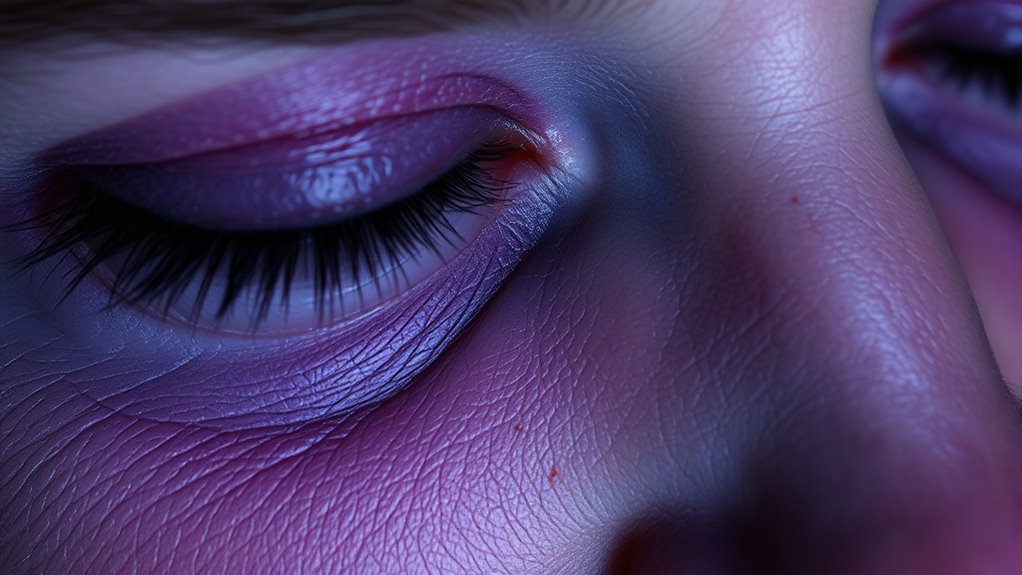
Dark circles under your eyes can make you look tired and worn out. These darkened patches often appear in shades of blue, purple, brown, or black, affecting your skin’s overall appearance.
The primary causes of dark circles include aging, genetics, lack of sleep, dehydration, and allergies. As you age, your skin thins, making blood vessels more visible. Genetics plays a significant role, with about 63% of individuals experiencing dark circles due to hereditary factors.
Aging, genetics, and lifestyle factors contribute to the appearance of dark circles under the eyes.
Skin conditions like eczema can worsen the look by increasing inflammation and pigmentation.
Thankfully, there are several treatment options available, including home remedies like cold compresses, proper hydration, and adequate sleep, as well as cosmetic solutions that can help reduce their visibility.
Who Do Dark Circles Under the Eyes Affect?
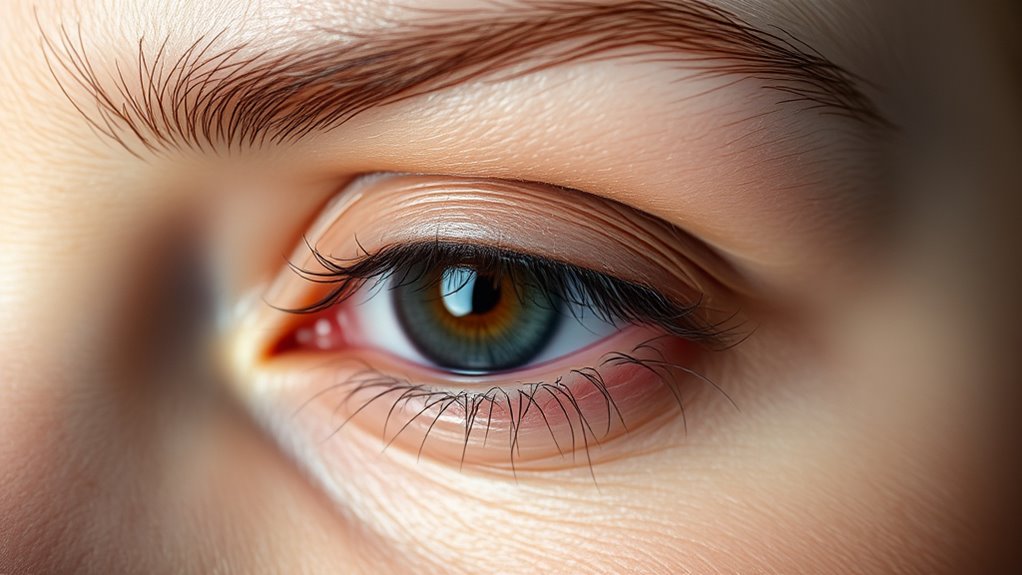
Who hasn’t noticed dark circles under their eyes, regardless of age, race, or gender? These dark circles can affect individuals for various reasons, making them a common cosmetic concern.
Here are some key points to reflect on:
- Family History: About 63% of people report a genetic predisposition to dark circles, suggesting that if your parents had them, you might too.
- Lifestyle Factors: Factors like smoking, lack of sleep, and excessive screen time can worsen the appearance of dark circles across all demographics.
- Skin Color: Dark circles may be more pronounced in individuals with darker skin tones, as they often experience increased pigmentation.
Additionally, maintaining a healthy lifestyle can help mitigate the impact of inadequate maintenance on your skin’s appearance.
Whether you’re young or old, dark circles can impact your look, but understanding the common causes is the first step toward addressing them.
What Causes Dark Circles Under Your Eyes?
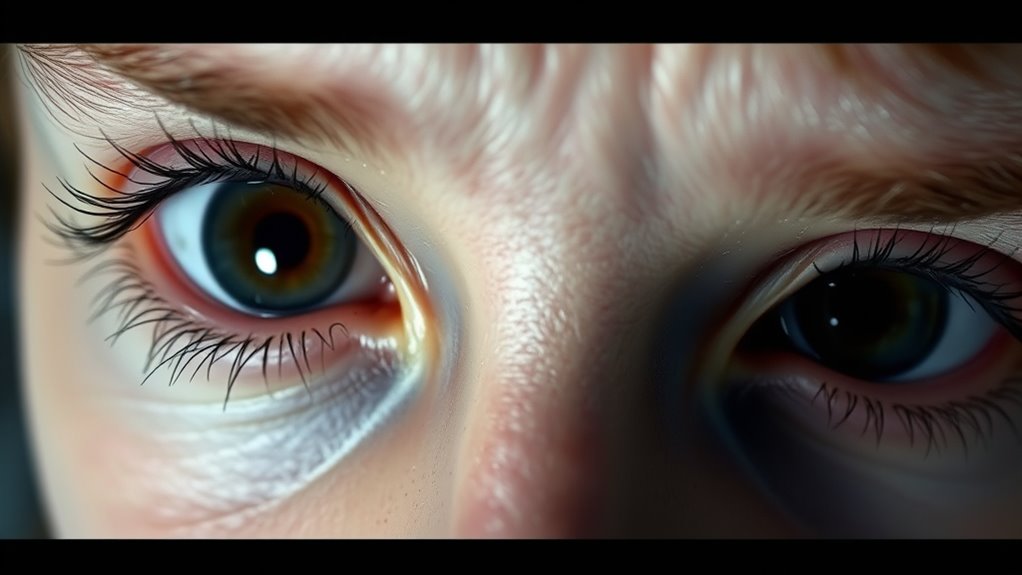
Various factors contribute to the appearance of dark circles under your eyes, making it important to understand their origins. One significant cause is aging, which thins your skin and makes blood vessels more visible.
Genetics also plays a role; studies show that about 63% of people with dark circles have a family history of the condition.
A lack of sleep can exacerbate dark circles, as it causes your skin to look paler and highlights darkened areas due to fluid retention.
Allergies trigger inflammation and increased pigmentation, leading to those shadows under your eyes.
Additionally, lifestyle factors like smoking, excessive alcohol consumption, and prolonged screen time can worsen dark circles by negatively affecting skin health and circulation.
What Can I Do at Home to Treat Dark Circles Under My Eyes?
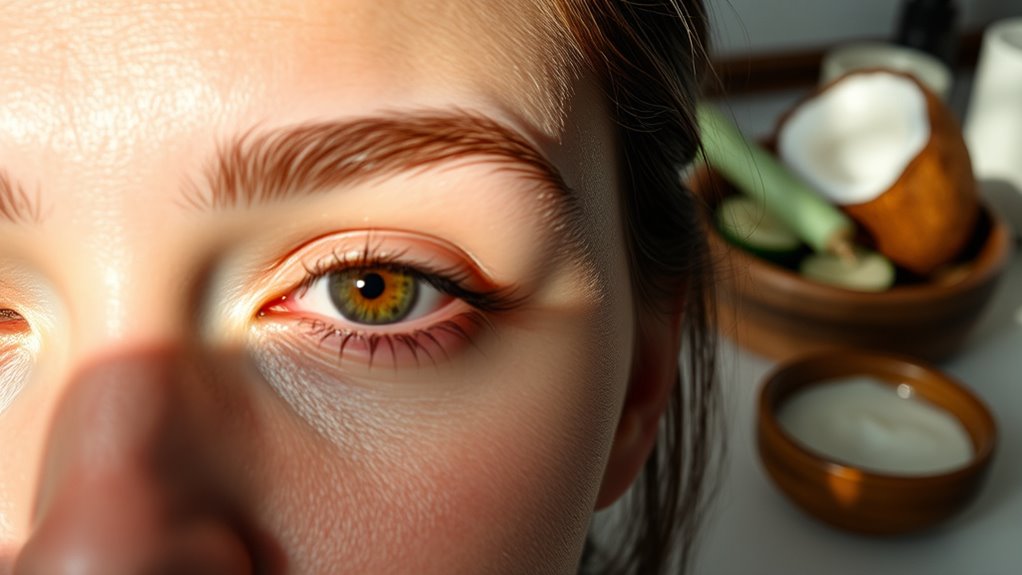
Wondering how to tackle those pesky dark circles at home? You’ve got several effective options.
Try these simple tips to brighten your under-eye area:
- Cold Compress: Apply a cold compress or chilled cucumber slices for 10-15 minutes. This constricts blood vessels, reducing puffiness and dark circles.
- Caffeine: Use cold teabags, especially those with caffeine. They improve circulation and help decrease swelling under your eyes due to their anti-inflammatory properties.
- Hydration & Diet: Stay hydrated and maintain a balanced diet rich in vitamins E, C, and K. This promotes skin health, helping to lessen the appearance of dark circles and puffy eyelids.
With these strategies, you can effectively combat dark circles and enhance your overall skin health!
What Medical Treatment Options Are Available to Treat Dark Circles Under the Eyes?

If home remedies aren’t giving you the results you want, medical treatments can offer more effective solutions for dark circles.
Topical treatments like creams with retinoids or caffeine can lighten pigmentation, while surgical options may help address deeper issues.
Consulting a dermatologist will help you identify the best approach for your specific needs.
Topical Treatments Overview
While dark circles under your eyes can be frustrating, several topical treatments offer effective solutions. Here are three options to evaluate:
- Topical Retinoids: These promote skin cell turnover and thicken the skin, making underlying blood vessels less visible.
- Hyaluronic Acid: Creams with hyaluronic acid, ceramides, and peptides hydrate the skin and stimulate collagen, potentially reducing the appearance of dark circles.
- Caffeine-Infused Eye Creams: These can constrict blood vessels and reduce puffiness, providing a quick fix for dark under-eye circles.
Additionally, if allergies are the cause, topical antihistamines may help reduce inflammation and pigmentation.
Look for products with skin-brightening properties, like licorice root extract, to combat hyperpigmentation effectively.
Surgical Intervention Options
Topical treatments can provide relief for dark circles, but sometimes more invasive options might be necessary for lasting results.
Surgical options include blepharoplasty, which removes excess fat to reduce puffiness and improve hollowness under your eyes.
If you’re looking for a non-surgical approach, tissue fillers like hyaluronic acid can add volume and smooth the skin, addressing shadowing effectively.
Laser therapy is another option, targeting pigmentation while stimulating collagen production to enhance skin texture.
Chemical peels can also help by exfoliating the skin, reducing pigmentation, and promoting an even tone.
It’s essential to consult a qualified dermatologist or plastic surgeon to identify the most appropriate surgical intervention based on your unique causes of dark circles.
How Can Dark Circles Under My Eyes Be Prevented?
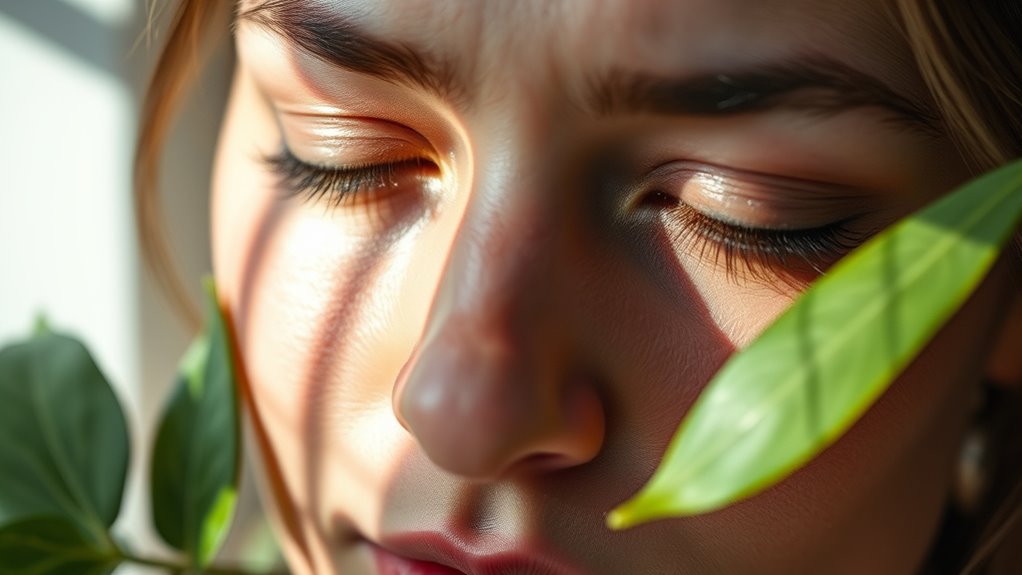
How can you effectively prevent dark circles under your eyes? Start by adopting healthy habits that nourish the skin around your eyes and enhance your overall well-being.
Here are three key strategies:
- Maintain a Regular Sleep Schedule: Aim for at least seven hours of sleep each night to combat fatigue and dull skin, reducing the appearance of dark circles. Lack of sleep can also lead to increased skin inflammation, further worsening the condition.
- Stay Hydrated: Drink plenty of water throughout the day to keep your skin hydrated. Dehydration can accentuate dark circles and diminish skin health.
- Manage Sun Exposure and Stress: Use sunscreen and sunglasses to protect against sun damage. Additionally, practice stress management techniques like exercise or meditation to improve skin health and minimize dark circles from stress. Incorporating essential oils like lavender oil can also enhance relaxation and help alleviate stress-related skin issues.
When Should I Call My Healthcare Provider?

Even with healthy habits in place, dark circles can sometimes persist or worsen, signaling that it’s time to seek professional advice. If you notice swelling in one eye, don’t hesitate to consult a healthcare provider, as this could indicate a serious condition. Persistent dark circles might signal underlying health issues like anemia or financial considerations related to insufficient nutrition or stress. Additionally, cognitive decline in conditions such as dementia may also manifest with changes in appearance, including dark circles under the eyes.
Here’s a quick guide to help you decide when to call your healthcare provider:
| Symptoms | Action Required |
|---|---|
| Persistent dark circles | Consult your healthcare provider |
| Swelling in one eye | Seek immediate medical attention |
| Changes in vision/skin texture | Consult a dermatologist |
| Accompanied by fatigue | Evaluate with a healthcare provider |
Staying proactive can make a difference!
Why Does My Baby or Child Have Dark Circles Under Their Eyes?
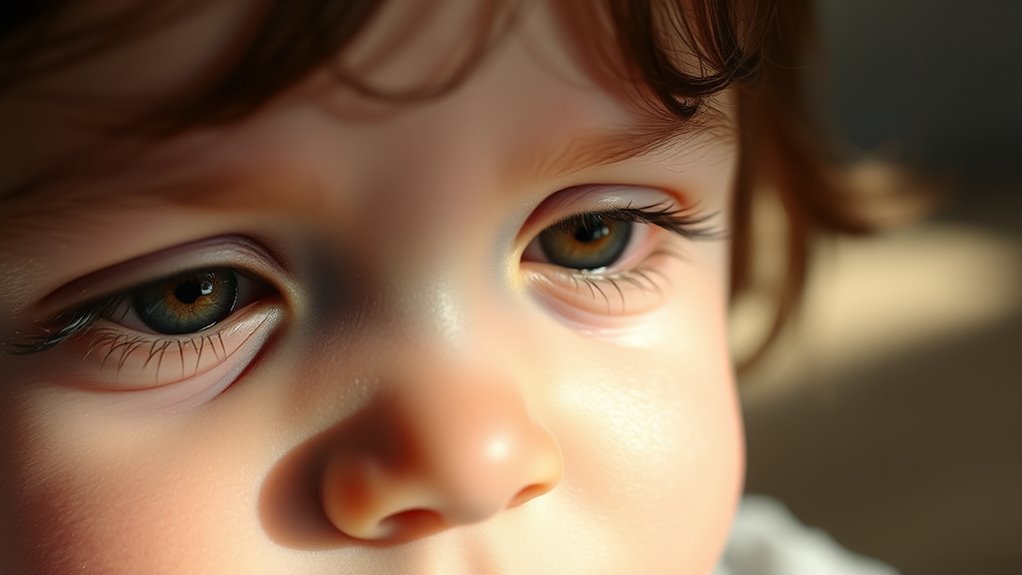
If you’ve noticed dark circles under your baby or child’s eyes, it could be a sign of several factors like lack of sleep, allergies, or even genetics. These circles often highlight fatigue or inflammation, making it essential to address any underlying issues. Keeping an eye on their sleep patterns and any allergy symptoms can help you determine the cause. Additionally, maintaining a consistent routine can promote better sleep and overall well-being, which is crucial for children’s well-being.
Common Causes in Children
Dark circles under your child’s eyes can be concerning for any parent, but they often arise from common, manageable factors.
Here are three primary causes to take into account:
- Fatigue: Insufficient sleep can lead to dark circles, making them more pronounced and noticeable.
- Allergies: Allergies can trigger inflammation and histamine release, causing dark circles due to increased pigmentation.
- Genetic Factors: A family history of dark circles may predispose your child to develop this condition, regardless of other factors.
While dark circles in children are usually not a cause for concern, it’s essential to consult a healthcare provider if they persist or worsen, especially if accompanied by other symptoms or skin conditions like eczema.
Impact of Allergies
Allergies can play a vital role in the appearance of dark circles under your child’s eyes. When allergens trigger a reaction, histamines are released, leading to inflammation and increased pigmentation in the skin.
If your child suffers from allergic rhinitis, nasal congestion can worsen dark circles by promoting fluid retention and poor circulation around the eyes. Rubbing or scratching their eyes in response to itching further irritates the area and can break blood vessels, intensifying the dark circles.
Fortunately, these dark circles might be temporary. Effective allergy management, including antihistamines and avoidance of allergens, can greatly improve your child’s appearance.
Recognizing the connection between allergies and dark circles is essential for addressing the underlying issue.
Importance of Sleep
Sleep is essential for your child’s overall health and well-being, and its lack can greatly contribute to the appearance of dark circles under their eyes. Insufficient sleep can lead to fatigue, making blood vessels more visible and resulting in a dull skin tone.
Here are three key points to contemplate:
- Duration: Children need at least seven hours of sleep each night to avoid dark circles and puffiness.
- Consistency: Irregular sleep patterns can worsen fatigue and fluid retention, leading to shadows under the eyes.
- Stress Factors: Stress from school or social interactions can exacerbate fatigue, making dark circles more pronounced.
If dark circles persist, consult a healthcare provider to rule out underlying health issues.
What Vitamins Are Good for Dark Circles Under the Eyes?

Many people seek effective solutions for dark circles under their eyes, and vitamins can play an essential role in this process.
Vitamins E, C, and K are particularly beneficial for skin health. Vitamin E acts as an antioxidant, protecting your skin from oxidative stress and helping diminish the visibility of dark circles.
Vitamin C is vital for collagen production, which thickens the skin under your eyes and reduces blood vessel visibility.
Meanwhile, vitamin K enhances circulation and may help minimize dark circles caused by vascular issues.
If your dark circles stem from anemia, consider iron supplements to improve red blood cell levels and enhance your skin’s appearance.
Incorporating these vitamins into your routine can greatly improve your under-eye area.
Frequently Asked Questions
What Is the Science Behind Dark Circles Under Eyes?
The science behind dark circles under your eyes involves several factors.
Aging and genetics contribute to thinner skin, making blood vessels more visible. Lack of sleep dulls your skin, highlighting these vessels.
Allergies can cause inflammation, leading to dilated blood vessels and pigmentation changes. Additionally, sun exposure boosts melanin production, resulting in hyperpigmentation.
Conditions like anemia can also play a role, as low red blood cell levels may contribute to the dark appearance.
What Actually Works for Dark Circles Under the Eyes?
You might feel trapped in a cycle of tiredness and frustration when dealing with dark circles.
Yet, simple solutions exist. Cold compresses and cucumber slices can work wonders for immediate relief, while topical treatments with hyaluronic acid and caffeine hydrate and rejuvenate.
Don’t underestimate the power of a good night’s sleep—aim for seven hours.
For more stubborn cases, consider medical options like chemical peels or laser therapy to restore your youthful glow.
What Really Covers Dark Circles Under Eyes?
To effectively cover dark circles under your eyes, you’ll want to choose a high-coverage concealer that matches your skin tone.
Look for formulas that include moisturizing ingredients to prevent creasing.
Applying a color corrector, like peach or orange, before the concealer can neutralize the dark tones.
Don’t forget to set it with a light powder to keep everything in place.
With these tips, you can achieve a bright and refreshed look.
What Is the Main Cause of Dark Circles Under the Eyes?
The main cause of dark circles under your eyes is often linked to aging, which thins your skin and makes blood vessels more visible.
Genetics also play a big role—if your family has a history of dark circles, you’re more likely to have them too.
Lack of sleep can worsen the issue, along with sun exposure, allergies, and lifestyle choices like smoking or heavy drinking, all contributing to their appearance.
Conclusion
In the end, dark circles under your eyes can feel like shadows lurking behind your brightness, but you don’t have to let them steal your sparkle. By understanding their causes and exploring both home remedies and medical treatments, you can reclaim your radiance. Remember, prevention is key, so prioritize good sleep and hydration. If those pesky shadows persist, it might be time to consult a healthcare provider to shine a light on your concerns.










